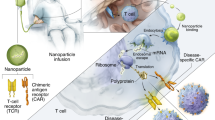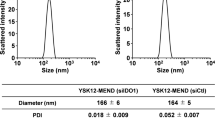Abstract
Dendritic cells (DC) are professional antigen-presenting cells playing a central role in the induction of antigen-specific cytotoxic T-lymphocytes (CTL). We analyzed the efficiency of tumor RNA transfection into DC using different sources of RNA as well as delivery strategies including electroporation, lipofection and CD71-receptor-based delivery. To evaluate the sensitivity of these approaches, we utilized in vitro transcribed enhanced green fluorescence protein (EGFP)-RNA and whole tumor RNA from EGFP-transfected renal cell carcinoma cell line N43. We demonstrate that electroporation was the most effective way yielding about 30% EGFP positive cells while less than 1% of DC expressed EGFP using the transferrin receptor transfection system. Delivery of RNA with liposomes resulted in 17.5% of EGFP positive cells depending on the RNA amount. However, when these approaches were applied to transduce DC with RNA derived from the A498 cell line for T-cell priming, tumor-specific CTL could be induced using all delivery strategies suggesting that this technology has the potential to induce cytotoxic T-cell response even when low level of antigen is delivered. Furthermore, we demonstrate that amplification of whole tumor messenger RNA (mRNA) as well as the use of total instead of purified mRNA can be utilized for stimulating tumor-specific CTL responses.
This is a preview of subscription content, access via your institution
Access options
Subscribe to this journal
Receive 12 print issues and online access
$259.00 per year
only $21.58 per issue
Buy this article
- Purchase on Springer Link
- Instant access to full article PDF
Prices may be subject to local taxes which are calculated during checkout






Similar content being viewed by others
References
Banchereau J, Steinman RM . Dendritic cells and the control of immunity. Nature 1998; 392: 245–252.
Cella M, Sallusto F, Lanzavecchia A . Origin, maturation and antigen presenting function of dendritic cells. Curr Opin Immunol 1997; 9: 10–16.
Bubenik J . Genetically engineered dendritic cell-based cancer vaccines. Int J Oncol 2001; 18: 475–478.
Brossart P, Wirths S, Brugger W, Kanz L . Dendritic cells in cancer vaccines. Exp Hematol 2001; 29: 1247–1255.
Sallusto F, Lanzavecchia A . Efficient presentation of soluble antigen by cultured human dendritic cells is maintained by granulocyte/macrophage colony stimulating factor plus interleukin 4 and down regulated by tumour necrosis factor. J Exp Med 1994; 179: 1109–1118.
Zhou L, Tedder TF . CD14 blood monocytes can differentiate into functionally mature CD83+ dendritic cells. Proc Natl Acad Sci USA 1996; 93: 2588–2592.
Brossart P et al. Generation of functional human dendritic cells from adherent peripheral blood monocytes by CD40 ligation in the absence of granulocyte-macrophage colony-stimulating factor. Blood 1998; 92: 4238–4247.
Bakker AB et al. Generation of antimelanoma cytotoxic T lymphocytes from healthy donors after presentation of melanoma-associated antigen-derived epitopes by dendritic cells in vitro. Cancer Res 1995; 55: 5330–5334.
Brossart P et al. Her-2/neu-derived peptides are tumor-associated antigens expressed by human renal cell and colon carcinoma lines and are recognized by in vitro induced specific cytotoxic T lymphocytes. Cancer Res 1998; 58: 732–736.
Seliger B et al. HER-2/neu is expressed in human renal cell carcinoma at heterogeneous levels independently of tumor grading and staging and can be recognized by HLA-A2.1-restricted cytotoxic T lymphocytes. Int J Cancer 2000; 87: 349–359.
Hsu FJ et al. Vaccination of patients with B-cell lymphoma using autologous antigen-pulsed dendritic cells. Nat Med 1996; 2: 52–58.
Brossart P, Bevan MJ . Presentation of exogenous protein antigens on major histocompatibility complex class I molecules by dendritic cells: pathway of presentation and regulation by cytokines. Blood 1997; 90: 1594–1599.
Specht JM et al. Dendritic cells retrovirally transduced with a model antigen gene are therapeutically effective against established pulmonary metastases. J Exp Med 1997; 186: 1213–1221.
Brossart P et al. Virus-mediated delivery of antigenic epitopes into dendritic cells as a means to induce CTL. J Immunol 1997; 158: 3270–3276.
Kaplan JM et al. Induction of antitumor immunity with dendritic cells transduced with adenovirus vector-encoding endogenous tumor-associated antigens. J Immunol 1999; 163: 699–707.
Condon C et al. DNA-based immunization by in vivo transfection of dendritic cells. Nat Med 1996; 2: 1122–1128.
Inaba K et al. Efficient presentation of phagocytosed cellular fragments on the major histocompatibility complex class II products of dendritic cells. J Exp Med 1998; 188: 2163–2173.
Herr W et al. Mature dendritic cells pulsed with freeze–thaw cell lysates define an effective in vitro vaccine designed to elicit EBV-specific CD4(+) and CD8(+) T lymphocyte responses. Blood 2000; 96: 1857–1864.
Chang JW et al. Induction of Th1 response by dendritic cells pulsed with autologous melanoma apoptotic bodies. Anticancer Res 2000; 20: 1329–1336.
Shaif-Muthana M et al. Dead or alive: immunogenicity of human melanoma cells when presented by dendritic cells. Cancer Res 2000; 60: 6441–6447.
Scott-Taylor TH et al. Human tumour and dendritic cell hybrids generated by electrofusion: potential for cancer vaccines. Biochim Biophys Acta 2000; 1500: 265–279.
Boczkowski D, Nair SK, Snyder D, Gilboa E . Dendritic cells pulsed with RNA are potent antigen-presenting cells in vitro and in vivo. J Exp Med 1996; 184: 465–472.
Nair SK et al. Induction of primary carcinoembryonic antigen (CEA)-specific cytotoxic T lymphocytes in vitro using human dendritic cells transfected with RNA. Nat Biotechnol 1998; 16: 364–369.
Boczkowski D et al. Induction of tumor immunity and cytotoxic T lymphocyte responses using dendritic cells transfected with messenger RNA amplified from tumor cells. Cancer Res 2000; 60: 1028–1034.
Nair SK et al. Induction of tumor-specific cytotoxic T lymphocytes in cancer patients by autologous tumor RNA-transfected dendritic cells. Ann Surg 2002; 235: 540–549.
Heiser A et al. Human dendritic cells transfected with RNA encoding prostate-specific antigen stimulate prostate-specific CTL responses in vitro. J Immunol 2000; 164: 5508–5514.
Heiser A et al. Human dendritic cells transfected with renal tumor RNA stimulate polyclonal T-cell responses against antigens expressed by primary and metastatic tumors. Cancer Res 2001; 61: 3388–3393.
Van Tendeloo VF et al. Highly efficient gene delivery by mRNA electroporation in human hematopoietic cells: superiority to lipofection and passive pulsing of mRNA and to electroporation of plasmid cDNA for tumor antigen loading of dendritic cells. Blood 2001; 98: 49–56.
Rock KL, York IA, Saric T, Goldberg AL . Protein degradation and the generation of MHC class I-presented peptides. Adv Immunol 2002; 80: 1–70.
Matz M et al. Amplification of cDNA ends based on template-switching effect and step-out PCR. Nucleic Acids Res 1999; 27: 1558–1560.
Flechsler I et al. Comparison of antisense vectors and antisense oligonucleotides delivered by means of the new cationic lipids Unifectin and maxifectin. Adv Exp Med Biol 1998; 451: 469–472.
Surovoy A, Flechsler I, Jung GA . Novel series of serum-resistant lipoaminoacid compounds for cellular delivery of plasmid DNA. Adv Exp Med Biol 1998; 451: 461–467.
Hoerr I, Obst R, Rammensee HG, Jung G . In vivo application of RNA leads to induction of specific cytotoxic T lymphocytes and antibodies. Eur J Immunol 2000; 30: 1–7.
Acknowledgements
We thank Sylvia Stephan for excellent technical assistance. This work was supported in part by a grant from the Deutsche Forschungsgemeinschaft (SFB 510, Project B2).
Author information
Authors and Affiliations
Rights and permissions
About this article
Cite this article
Grünebach, F., Müller, M., Nencioni, A. et al. Delivery of tumor-derived RNA for the induction of cytotoxic T-lymphocytes. Gene Ther 10, 367–374 (2003). https://doi.org/10.1038/sj.gt.3301901
Received:
Accepted:
Published:
Issue Date:
DOI: https://doi.org/10.1038/sj.gt.3301901
Keywords
This article is cited by
-
Evaluation of RNA Amplification Methods to Improve DC Immunotherapy Antigen Presentation and Immune Response
Molecular Therapy - Nucleic Acids (2013)
-
CD8+ T-cell priming and boosting: more antigen-presenting DC, or more antigen per DC?
Cancer Immunology, Immunotherapy (2013)
-
Allogeneic mRNA-based electrotransfection of autologous dendritic cells and specific antitumor effects against osteosarcoma in rats
Medical Oncology (2012)
-
Phase I/II trial of a dendritic cell vaccine transfected with DNA encoding melan A and gp100 for patients with metastatic melanoma
Gene Therapy (2011)
-
Intradermal Vaccinations With RNA Coding for TAA Generate CD8+ and CD4+ Immune Responses and Induce Clinical Benefit in Vaccinated Patients
Molecular Therapy (2011)



